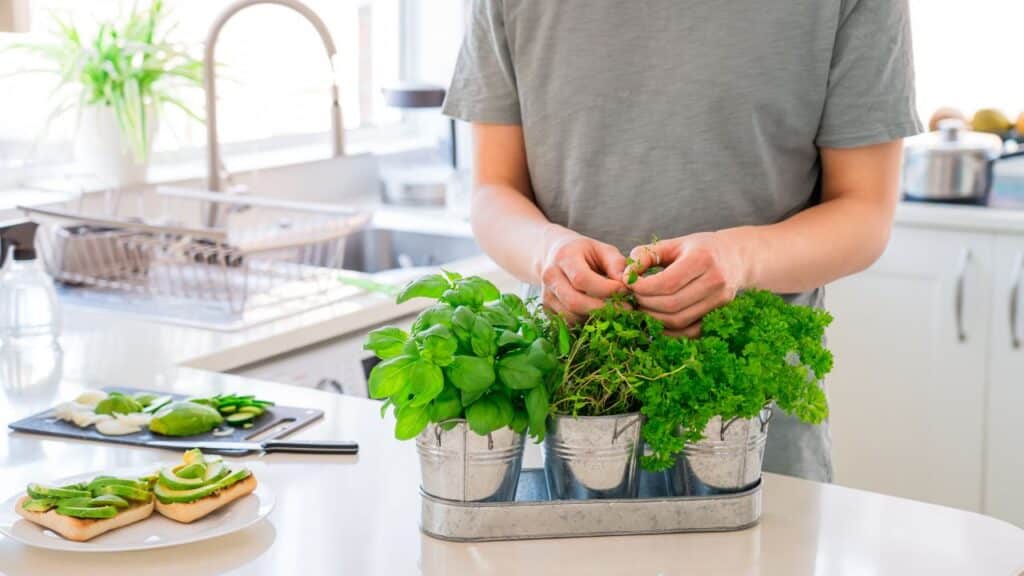In today’s fast-paced world, creating a sanctuary within our homes has become a priority. One way to achieve this is by adding greenery, which not only elevates the aesthetic appeal but also improves air quality and mental well-being.
If you’re short on space or want to bring a modern touch to your decor, vertical gardens are the perfect solution. This versatile approach to home gardening offers practical, space-saving, and visually appealing ways to bring nature indoors or enhance outdoor spaces.
In this guide, we’ll explore seven creative and practical ways to incorporate vertical gardens at home, making your living spaces more vibrant and sustainable.
Why Vertical Gardens Are a Perfect Fit for Modern Homes?
Benefits of Vertical Gardens
Vertical gardens are more than just a trend; they offer numerous advantages that make them an excellent addition to any home:
- Space-Saving Design: Ideal for small apartments and urban living, vertical gardens maximize greenery without taking up valuable floor space.
- Improved Air Quality: Plants act as natural air purifiers, removing toxins and increasing oxygen levels indoors.
- Enhanced Aesthetic Appeal: A vertical garden can serve as a stunning focal point, adding texture and color to plain walls.
- Noise Reduction: Dense plant walls can act as sound barriers, dampening noise in busy neighborhoods.
| Benefit | Description |
| Space-Saving Design | Ideal for compact areas, using vertical spaces effectively. |
| Improved Air Quality | Acts as a natural purifier, reducing toxins and boosting oxygen levels. |
| Aesthetic Appeal | Adds a touch of elegance and greenery to any home decor. |
| Noise Reduction | Provides a sound-dampening effect, creating a peaceful environment. |
How Vertical Gardens Align with Sustainability Trends?
Vertical gardens promote eco-friendly living by using recycled materials, conserving water through efficient irrigation systems, and encouraging homegrown produce. They reduce reliance on store-bought goods and can help lower your carbon footprint, aligning perfectly with modern sustainability goals.
Popular Types of Vertical Gardens
- Modular Systems: Pre-made kits with built-in irrigation, perfect for beginners.
- Freestanding Structures: Movable and versatile, great for both indoors and outdoors.
- DIY Wall-Mounted Options: Customized designs tailored to fit your space and style.
| Type | Features | Ideal For |
| Modular Systems | Built-in irrigation, easy to install | Beginners |
| Freestanding Structures | Portable and adaptable for multiple locations | Indoor and outdoor use |
| DIY Wall-Mounted Options | Customizable designs with personal touches | Creative homeowners with unique spaces |
7 Creative Ways to Incorporate Vertical Gardens into Your Home
Let’s take a closer look
1. Transform Your Living Room with a Vertical Wall Garden
A vertical garden can become the centerpiece of your living room, offering a fresh and inviting ambiance. These gardens can redefine the atmosphere by adding natural colors and textures, turning plain walls into vibrant displays of greenery. Adding a vertical garden to your living space also creates a conversation starter while enhancing the room’s functionality.
Key Tips:
- Choose plants like pothos, philodendrons, or ferns for low-maintenance options.
- Use a modular system with a built-in watering mechanism for hassle-free upkeep.
- Enhance the look with decorative planters or add LED grow lights for visual appeal and plant health.
| Plant Options | Special Features |
| Pothos | Tolerates low light and grows quickly. |
| Philodendrons | Easy to maintain and air-purifying. |
| Ferns | Adds lush greenery to living spaces. |
2. Build a Kitchen Herb Garden
Cooking becomes more enjoyable with fresh herbs at your fingertips. A vertical herb garden in your kitchen adds both functionality and charm, offering a sustainable way to access fresh, aromatic ingredients year-round. It’s a great way to save money, reduce waste, and enjoy better-tasting meals.
How to Start:
- Use hanging planters or a wall-mounted rack with small pots.
- Grow herbs like basil, thyme, mint, and parsley, which thrive indoors.
- Ensure the garden is near a window for natural light or install grow lights for sufficient illumination.
| Herb | Ideal Light Conditions | Uses |
| Basil | Bright, indirect sunlight | Great for Italian dishes. |
| Mint | Moderate sunlight | Perfect for beverages. |
| Thyme | Full sunlight | Adds flavor to savory meals. |
3. Use Vertical Gardens as a Balcony Screen
Turn your balcony into a private retreat by using vertical gardens as natural screens. This approach combines privacy with functionality, giving you a secluded area adorned with greenery. Vertical gardens on balconies also reduce heat, making outdoor spaces more comfortable during warmer months.
Benefits:
- Add privacy while improving outdoor aesthetics.
- Select sturdy outdoor plants like jasmine, lavender, or ivy.
- Choose weather-resistant materials for the vertical garden structure.
| Plant | Advantages |
| Jasmine | Fragrant blooms, ideal for privacy. |
| Lavender | Soothing scent, repels insects. |
| Ivy | Hardy climber, easy to maintain. |
4. Create a Relaxing Bedroom Oasis
A vertical garden in your bedroom can promote relaxation and better sleep. This innovative design feature creates a serene and rejuvenating atmosphere perfect for unwinding. Studies show that indoor plants can lower stress levels and improve sleep quality, making a bedroom garden a wise investment.
Plant Choices:
- Opt for air-purifying plants like snake plants, peace lilies, or bamboo palms.
- Use compact systems that fit seamlessly into bedroom corners or above headboards.
| Plant | Sleep Benefits |
| Snake Plant | Releases oxygen at night. |
| Peace Lily | Reduces air pollutants. |
| Bamboo Palm | Adds humidity to dry air. |
5. Design a Vertical Garden for Your Bathroom
Bathrooms are often overlooked when it comes to home decor, but they’re ideal for humidity-loving plants. A vertical garden in this space brings a spa-like vibe to your home, making your daily routines more enjoyable. Additionally, these plants can naturally absorb moisture and prevent damp odors.
Suggestions:
- Install a small vertical garden near the shower or sink.
- Use plants like ferns, orchids, or spider plants that thrive in moist environments.
- Ensure proper ventilation to prevent mold growth.
| Plant | Reason for Suitability |
| Ferns | Thrive in humid conditions. |
| Orchids | Require minimal care. |
| Spider Plants | Adaptable and easy to grow. |
6. Outdoor Fences with Green Walls
Upgrade your backyard fence into a vibrant green wall that serves as both decoration and privacy enhancement. This design can turn a plain backyard into a dynamic outdoor space. Outdoor vertical gardens can also provide habitat for pollinators like bees and butterflies, enhancing biodiversity in your area.
Best Practices:
- Use durable plants like succulents, grasses, or climbing roses.
- Incorporate drip irrigation for efficient watering.
- Choose lightweight materials to avoid overloading the fence.
| Plant | Outdoor Benefits |
| Succulents | Low water requirement. |
| Climbing Roses | Adds color and fragrance. |
| Grasses | Provides texture and movement. |
7. Add Vertical Gardens to Home Office Spaces
Incorporating greenery into your workspace boosts productivity and reduces stress. A vertical garden in your office can help create a more focused and inviting environment. Plants in workspaces have been linked to improved concentration and overall job satisfaction.
Tips for Setup:
- Use compact wall-mounted planters for small office spaces.
- Grow low-maintenance plants like ZZ plants, pothos, or philodendrons.
- Position the garden where it’s visible but doesn’t obstruct your workspace.
| Plant | Office-Friendly Features |
| ZZ Plant | Requires minimal light and care. |
| Pothos | Purifies air, easy to grow. |
| Philodendrons | Adds lush greenery. |
Tips for Maintaining Vertical Gardens
Choosing the Right Plants for Your Environment
- Assess light availability and temperature in your chosen location.
- Select plants that match your skill level and the garden’s conditions.
Watering and Fertilization Strategies
- Install self-watering systems for convenience.
- Regularly check soil moisture and fertilize plants as needed.
Pest Control and Plant Health
- Use natural pest repellents like neem oil or insecticidal soap.
- Inspect plants weekly for signs of disease or pests.
| Maintenance Task | Recommended Frequency |
| Watering | Weekly or as needed. |
| Fertilization | Monthly for most plants. |
| Pest Inspection | Weekly to prevent infestations. |
Tools and Materials Needed for Vertical Gardens
Essentials for DIY Vertical Garden Projects
- Wall-mounted racks or freestanding frames
- Planters, soil, and organic fertilizers
- Irrigation systems or watering cans
Best Ready-Made Kits for Vertical Gardening
- Wall-Mounted Planter Sets: Easy to install and maintain.
- Modular Garden Systems: Include irrigation and support systems for beginners.
- Freestanding Vertical Planters: Portable and versatile for indoor and outdoor use.
| Kit Type | Features |
| Wall-Mounted Planters | Compact and easy to assemble. |
| Modular Systems | Built-in irrigation, ideal for beginners. |
| Freestanding Planters | Portable and adaptable to any location. |
Interactive Elements and Bonus Tips
Table: Best Plants for Vertical Gardens by Room
| Room | Best Plants | Special Features |
| Living Room | Snake Plant, Pothos | Low-light tolerant |
| Kitchen | Basil, Mint, Thyme | Culinary uses |
| Bathroom | Ferns, Peace Lily | Thrive in high humidity |
| Balcony | Lavender, Jasmine | Fragrant outdoor options |
Quick List: Do’s and Don’ts for Vertical Gardens
- Do: Choose plants that suit your home’s lighting and humidity.
- Don’t: Overcrowd plants, which can hinder growth.
- Do: Invest in a reliable irrigation system to save time.
- Don’t: Ignore pest control; it’s essential for plant health.
Final Thoughts
Vertical gardens offer a unique way to incorporate greenery into your home, enhancing both style and functionality. Whether you’re looking to create a serene bedroom retreat, a vibrant kitchen herb garden, or a stylish office space, there’s a vertical garden solution for you. Start small, choose the right plants for your environment, and enjoy the transformation as you bring nature indoors.
For more tips on home improvement and gardening, visit Editorialge.






































